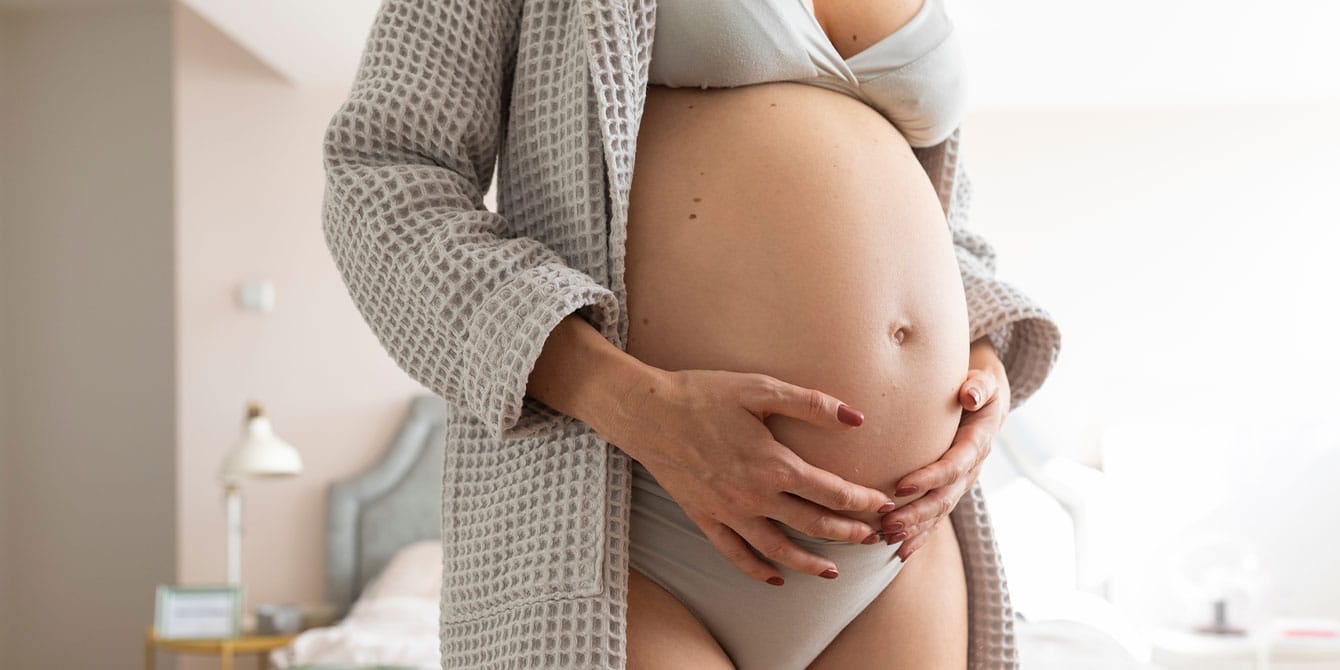It took until week 27 for my bleeding during pregnancy to resolve, but my son is perfect

Lumina/Stocksy
Although pregnancy spotting shouldn't be ignored, it isn’t always a major cause for concern, experts note.
Table of Contents
Of all the things you expect from a pregnancy—cravings, morning sickness, a child—bleeding during pregnancy is not one of them. Much like a regular period, blood is generally considered to be an indicator that you’re not pregnant. A welcome relief after a night out in your early 20s, maybe, but when you’re pregnant, it’s the last thing you want to see.
I experienced non-stop bleeding until week 27 and spent my entire pregnancy worrying that I was going to lose my baby. My first clue was brown spotting, similar to something you might see at the end of your period or at implantation. Then, shortly after my 12-week scan—the point where most pregnant people prepare to share their happy news—the bleeding intensified, transitioning into a bright red, heavy flow that would persist until my third trimester. Little did I know, the bleeding was a symptom of a subchorionic hematoma— and my son would be perfectly fine.
Subchorionic hematomas are bleeds between the placenta and the uterus during pregnancy and, to my surprise, something doctors see regularly. Although some can be associated with adverse pregnancy outcomes, bleeding during pregnancy isn’t always a cause for concern, though it should always be checked out by a healthcare provider. But despite pregnancy spotting and bleeding being incredibly common, it feels like no one talks about it. So, with an adorable, healthy 20-month-old bouncing on my lap, let’s talk about it.
Related: The new mama’s guide to pregnancy symptoms
What causes a subchorionic hematoma?
The short answer is that we don’t always know for sure. Research suggests subchorionic hematomas are the result of the partial detachment of the chorionic membranes from the uterine wall,1Bondick CP, M Das J, Fertel H. Subchorionic Hemorrhage. In: StatPearls. Treasure Island (FL): StatPearls Publishing; August 3, 2022. https://www.ncbi.nlm.nih.gov/books/NBK559017/ and this can be attributed to a myriad of reasons. These include uterine malformation, a history of recurrent pregnancy loss or pelvic infection. Yet in many cases—like mine—there are no known risk factors and a reason isn’t always identifiable.
Dr. Jacques Moritz, MD, an OB-GYN and medical director of New York’s Tia clinic, says sometimes we have no idea why a subchorionic hematoma occurs, but that it’s unlikely to be caused by anything anyone did or didn’t do.
Still, he says bleeding during pregnancy is not normal and should never be ignored.
“Any sign of bleeding early in pregnancy needs to be evaluated to make sure it’s not ectopic or a miscarriage,” he says.
“If there’s a small subchorionic hematoma, they’re most likely to be reabsorbed and won’t pose any risk. However, a very large one will need to be followed closely.”
Related: Ectopic pregnancy: Signs to watch out for before your first prenatal appointment
How common is it?
I hadn’t heard of subchorionic hematoma until the sonographer pointed it out on the ultrasound screen. None of my friends with children had shared experiences of pregnancy spotting and I found my symptoms and diagnosis both shocking and alienating. But the statistics paint a different picture, with an incidence of 16% to 25% of pregnancies complicated by vaginal bleeding in the first-trimester. That’s as many as one in four.
Midwife and founder of Restore Midwifery, Marea Goodman, says although subchorionic hematomas can be associated with adverse pregnancy outcomes, they are relatively common and rarely cause major issues.
Related: 10 sneaky pregnancy symptoms you might not know about
“Subchorionic hematomas are the most common causes of vaginal bleeding in people from 10 to 20 weeks pregnant and make up about 11% of all cases of bleeding during pregnancy,” she says.
Dr Moritz agrees and says this is something he sees in practice daily.
And while some women might go on to miscarry—an outcome that can also start with bleeding—it’s important to understand that many do not.
What are the symptoms?
The most obvious, tangible sign of a subchorionic hematoma is bleeding. Some people may also experience pelvic pain and uterine cramping. In other instances, someone could have a subchorionic hematoma without vaginal bleeding and the only way to confirm a diagnosis is by an ultrasound.
While it can be normal to experience light bleeding during pregnancy (pink or red spotting that resolves within 24 hours, especially after strenuous exercise or sexual activity), Goodman says there are warning signs to look out for. These include uterine contractions, filling a pad in less than an hour or feeling dizzy or lightheaded from blood loss.
Related: Is it implantation bleeding or an early period? Here’s how to tell the difference
My worst bleed at 24 weeks was particularly hard to miss because not only did I feel it, I managed to leave a trail from my sofa to the bathroom. But although this resulted in a three-week hospital stay and the passing of a few medium-sized clots, there was no change to my baby’s condition— a timely point to remind you all that today that same baby is healthy and gorgeous at 20 months.
So is there anything we can do at home?
“According to research there really isn’t anything to do to prevent or help heal a subchorionic hematoma except for the wait and see approach [unfortunately],” Goodman says.
“I think getting support around mental health and tools to reduce anxiety are the most helpful for people experiencing a subchorionic hematoma.”
How long does it take for a subchorionic hematoma to resolve?
This ‘wait and see approach’ can feel frustrating, but the nature of subchorionic hematomas means there’s not a one-size-fits-all prognosis. Each case is different and while many resolve themselves, some women will continue to bleed throughout their pregnancy.
Dr Moritz says most subchorionic hematomas resolve before 20 weeks, but that bleeding as long as I did puts me in the extreme category and warranted the close monitoring I was given. He reiterates that any bleeding should be investigated, but particularly those that haven’t reabsorbed beyond 20 weeks.
What are the risks? Should I worry about subchorionic hemorrhage?
A 2021 study found that a large subchorionic hematoma might indicate an increased risk of adverse pregnancy outcomes including early pregnancy loss, intrauterine growth restriction (IUGR) placental abruption or preterm delivery.2Günay T, Yardımcı OD. How does subchorionic hematoma in the first trimester affect pregnancy outcomes?. Arch Med Sci. 2021;18(3):639-646. Published 2021 Jan 8. doi:10.5114/aoms/113645 Another concluded that first trimester subchorionic hematomas are not associated with adverse pregnancy outcomes at more than 20 weeks gestation.3Naert, Mackenzie N. BA; Muniz Rodriguez, Alberto BA; Khadraoui, Hanaa BA; Naqvi, Mariam MD; Fox, Nathan S. MD. Association Between First-Trimester Subchorionic Hematomas and Adverse Pregnancy Outcomes After 20 Weeks of Gestation in Singleton Pregnancies. Obstetrics & Gynecology: October 2019. Volume 134. Issue 4. p 863-868. doi: 10.1097/AOG.0000000000003487
It’s important to note that just because subchorionic hematomas can be associated with pregnancy complications, it doesn’t mean that they will be. Plus, there are other factors to consider in determining the outcome and management, particularly size. Goodman explains that the size of the subchorionic hematoma matters in relation to risk and should be taken into context.
Related: High blood pressure in pregnancy may be rising—especially among Millennial and Gen Z moms
“If the subchorionic hematoma is larger than 25% of the total volume of the amniotic sac, there is a higher risk of losing the pregnancy,” she says.
“As a midwife, as long as the subchorionic hematoma is less than that [and most are], I generally counsel my patients to not worry too much [although to understand the signs of when to get medical care.]”
This should offer some comfort, but I get it, bleeding in pregnancy regardless of size, frequency and gestation will always be a horrible thing to experience. Still, overall the clinical significance of a subchorionic hematoma continues to warrant further investigation—and more conversations.
Related: The new mama’s guide to pregnancy symptoms
When my waters broke at 31+6, no one could explain why. Perhaps it was linked to the subchorionic hematoma of weeks gone by, or there was something else at play. But today my son is 20 months old and thriving. There are no battle scars to hint at the traumatic pregnancy we endured, and I don’t see reason to mentally review our experience if not to support others in a similar situation.
A note from Motherly: Bleeding during pregnancy
Spotting or bleeding during pregnancy will always be worrying, but it won’t necessarily symbolize the beginning of the end.
Involve your maternity team every step of the way and know that subchorionic hematomas, including in those pregnancies that result in the delivery of healthy babies, are much more common than you think.
Featured experts
Marea Goodman, LM, CPM, is a licensed midwife and founder of Restore Midwifery in Santa Cruz, CA.
Jacques Moritz, MD is a board-certified OB-GYN and medical director at Tia with more than 30 years practice in New York City.
Sources
- Bondick CP, M Das J, Fertel H. Subchorionic Hemorrhage. In: StatPearls. Treasure Island (FL): StatPearls Publishing; August 3, 2022. https://www.ncbi.nlm.nih.gov/books/NBK559017/
- Günay T, Yardımcı OD. How does subchorionic hematoma in the first trimester affect pregnancy outcomes?. Arch Med Sci. 2021;18(3):639-646. Published 2021 Jan 8. doi:10.5114/aoms/113645
- Naert, Mackenzie N. BA; Muniz Rodriguez, Alberto BA; Khadraoui, Hanaa BA; Naqvi, Mariam MD; Fox, Nathan S. MD. Association Between First-Trimester Subchorionic Hematomas and Adverse Pregnancy Outcomes After 20 Weeks of Gestation in Singleton Pregnancies. Obstetrics & Gynecology: October 2019. Volume 134. Issue 4. p 863-868. doi: 10.1097/AOG.0000000000003487
Source(s)
- 1Bondick CP, M Das J, Fertel H. Subchorionic Hemorrhage. In: StatPearls. Treasure Island (FL): StatPearls Publishing; August 3, 2022. https://www.ncbi.nlm.nih.gov/books/NBK559017/
- 2Günay T, Yardımcı OD. How does subchorionic hematoma in the first trimester affect pregnancy outcomes?. Arch Med Sci. 2021;18(3):639-646. Published 2021 Jan 8. doi:10.5114/aoms/113645
- 3Naert, Mackenzie N. BA; Muniz Rodriguez, Alberto BA; Khadraoui, Hanaa BA; Naqvi, Mariam MD; Fox, Nathan S. MD. Association Between First-Trimester Subchorionic Hematomas and Adverse Pregnancy Outcomes After 20 Weeks of Gestation in Singleton Pregnancies. Obstetrics & Gynecology: October 2019. Volume 134. Issue 4. p 863-868. doi: 10.1097/AOG.0000000000003487


































